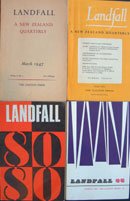Landfall
'At last it was time for
something new to begin.'
Indirections
|
|
'The name, Landfall,
is meant to indicate that we have just begun to see our country,
but hardly know as yet what sort of country it is going to be.'
|
| Landfall,
v.1, no.1 (March 1947) - v.20, no.4 (December 1966). |
Although a 'literary review', Landfall also encompassed the arts. The avowed aim of the periodical was 'to rediscover a just relationship between the arts and man's other activities, and a single scale of values to which all can be referred.' The second aim defined the New Zealand context for this cultural activity: a province of European culture, but one which could develop its own centre, and one situated in the South Pacific that has the opportunity to enrich its basically European cultures by its relationship with other Pacific and Asian cultures. Indeed, Landfall was the right journal at the right time, and its success as a thoroughly contemporary journal premised on literary and intellectual excellence was based on Brasch's considered editorship. Standards were set and a canon was created; a solid base formed for future literary and artistic endeavours.
The 1940s centennial celebrations included publications such as Eric McCormick's Letters and Art in New Zealand and Arthur Sewell's 1840 and after. Social-literary commentary had begun with Holcroft, McCormick, J.C. Reid and others. Frank Sargeson, and a few poets, produced works with a distinctly New Zealand setting. Allen Curnow in his 1945 A Book of New Zealand Verse confidently excluded pre-1920s poetry. In 1941 the National Film Unit was formed. In 1947, Peter Fraser's government founded the National Orchestra and established the New Zealand Literary Fund. Landfall (its first proposed title was Tuatara) also appeared that year, with Brasch as the full time editor. The message was clear: it was to be a New Zealand journal exhibiting the best work of New Zealand writers, and show that New Zealand could stand on its own 'cultural' feet. Brasch edited 78 of the 80 issues between 1947 and 1966 (W. H. Oliver edited two while Brasch was overseas in 1957): the single most outstanding contribution by an individual to New Zealand's cultural heritage.
Tomorrow was edited by Kennaway Henderson, who according to Denis Glover, was 'the nicest, quietist, kindliest man in the country.' This satirical and witty weekly journal first appeared on 11 July 1934. In just under seven years the Christchurch-based Henderson printed more than 30 early stories by Frank Sargeson and Roderick Finlayson, poetry by Mason, Glover, Fairburn, and Curnow, and numerous reviews of New Zealand books. Although Brasch found Henderson's own cartoons off-putting (others called them ferocious), he maintained that Tomorrow was a very influential New Zealand periodical.
The periodical the Phoenix was a product
of the 'Hungry Thirties' in New Zealand. It lasted only
four issues (1932-33) with the first two edited by James Bertram and
the last two by R. A. K. Mason. Bob Lowry was the printer. According
to Brasch, Phoenix signaled a great advance: 'It
announced the birth of a new literature. It struck the first notes of
informed adult enquiry and criticism in a hitherto complacent, uncritical,
incurious society…'. He contributed two poems, an article,
and a short piece on D'Arcy Cresswell to the first issue. His
'Mountain Storm' sits opposite the editor's note in
this third issue.
Inspiration for Landfall
was from a mix of local and international magazines. On the home front
there was Bertram's Phoenix, Henderson's Tomorrow,
and the miscellaneous Book. The main overseas publications
were T.S. Eliot's The Criterion, Christopher Dawson's
Dublin Review, and John Middleton Murry's The Adelphi.
Brasch also read the Nouvelle Revue Française, and the
Neue Rundschau, two of the best French and German journals,
Horizon, the Paris-American Transition, and The
Dial. From all these, and with Glover's expertise at The
Caxton Press, the desired result was achieved. This is an early copy
of Murry's The Adelphi.
In 1962 Brasch edited Landfall Country, a 460
page anthology of stories, poems and 'explorations' from
Landfall. This publication was a significant pointer to the journal's
early achievement. It also provided an indicator to what Brasch appreciated
in a story or poem, and a summary of his social and political views
at that time: education, the 1951 waterside dispute, the conservation
of natural resources, and artistic freedom. Molly Macalister's
'Standing figure' stands opposite Fleur Adcock's 'Prince
to Kitchenmaid.'
